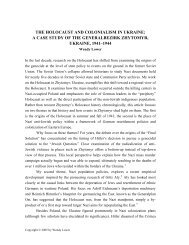Effects of Teachers' Mathematical Knowledge for Teaching on - Apple
Effects of Teachers' Mathematical Knowledge for Teaching on - Apple
Effects of Teachers' Mathematical Knowledge for Teaching on - Apple
Create successful ePaper yourself
Turn your PDF publications into a flip-book with our unique Google optimized e-Paper software.
Hill, Rowan, & Ball<br />
knowing how to represent quantities such as 1/4 or .65 using diagrams, how<br />
to provide a mathematically careful explanati<strong>on</strong> <str<strong>on</strong>g>of</str<strong>on</strong>g> divisibility rules, or how<br />
to appraise the mathematical validity <str<strong>on</strong>g>of</str<strong>on</strong>g> alternative soluti<strong>on</strong> methods <str<strong>on</strong>g>for</str<strong>on</strong>g> a<br />
problem such as 35 × 25. The desire to design survey measures <str<strong>on</strong>g>of</str<strong>on</strong>g> teacher<br />
knowledge also led developers to c<strong>on</strong>struct items centered directly <strong>on</strong> the<br />
c<strong>on</strong>tent <str<strong>on</strong>g>of</str<strong>on</strong>g> the K–6 curriculum rather than items that might appear <strong>on</strong> a middle<br />
school or high school exam. Details <strong>on</strong> design, c<strong>on</strong>structi<strong>on</strong>, and scaling<br />
are presented below.<br />
Method<br />
In this secti<strong>on</strong>, we <str<strong>on</strong>g>of</str<strong>on</strong>g>fer an overview <str<strong>on</strong>g>of</str<strong>on</strong>g> the present project, describing the<br />
sample <str<strong>on</strong>g>of</str<strong>on</strong>g> students and teachers participating in the study and providing<br />
in<str<strong>on</strong>g>for</str<strong>on</strong>g>mati<strong>on</strong> <strong>on</strong> data collecti<strong>on</strong> instruments and resp<strong>on</strong>se rates. We also explain<br />
the data analysis methods and model specificati<strong>on</strong>s used to estimate the relati<strong>on</strong>ship<br />
between teachers’ c<strong>on</strong>tent knowledge <str<strong>on</strong>g>for</str<strong>on</strong>g> teaching and students’<br />
gains in mathematics achievement.<br />
Sample<br />
The data presented here were derived from a study <str<strong>on</strong>g>of</str<strong>on</strong>g> schools engaged in<br />
instructi<strong>on</strong>al improvement initiatives. As part <str<strong>on</strong>g>of</str<strong>on</strong>g> this study, researchers collected<br />
survey and student achievement data from students and teachers in<br />
115 elementary schools during the 2000–2001 through 2003–2004 school<br />
years. Eighty-nine <str<strong>on</strong>g>of</str<strong>on</strong>g> the schools in this study were participating in <strong>on</strong>e <str<strong>on</strong>g>of</str<strong>on</strong>g><br />
three leading Comprehensive School Re<str<strong>on</strong>g>for</str<strong>on</strong>g>m programs—America’s Choice,<br />
Success <str<strong>on</strong>g>for</str<strong>on</strong>g> All, and the Accelerated Schools Project—with roughly 30 schools<br />
in each program. In additi<strong>on</strong>, 26 schools not participating in <strong>on</strong>e <str<strong>on</strong>g>of</str<strong>on</strong>g> these<br />
programs were included as comparis<strong>on</strong> schools. Program schools were<br />
selected <str<strong>on</strong>g>for</str<strong>on</strong>g> the study via probability sampling from lists supplied by the parent<br />
programs, 2 with some geographical clustering to c<strong>on</strong>centrate field staff<br />
resources. Comparis<strong>on</strong> schools were selected to match program schools in<br />
terms <str<strong>on</strong>g>of</str<strong>on</strong>g> community disadvantage and district setting. Once schools agreed<br />
to participate in the study, project staff approached all classroom teachers in<br />
each school to encourage their involvement.<br />
The sample <str<strong>on</strong>g>of</str<strong>on</strong>g> schools included in this study differed from a nati<strong>on</strong>ally<br />
representative sample <str<strong>on</strong>g>of</str<strong>on</strong>g> schools in two ways. First, the sampling procedure<br />
deliberately selected schools engaged in instructi<strong>on</strong>al improvement; sec<strong>on</strong>d,<br />
the sample was deliberately c<strong>on</strong>structed to overrepresent high-poverty elementary<br />
schools in urban, urban fringe, and suburban areas. In particular,<br />
whereas 1999 statistics showed that the average U.S. school served neighborhoods<br />
where 13% <str<strong>on</strong>g>of</str<strong>on</strong>g> households were in poverty, the average school in<br />
the present sample served neighborhoods where 19% <str<strong>on</strong>g>of</str<strong>on</strong>g> households were<br />
in poverty (Bens<strong>on</strong>, 2002). Moreover, 68% <str<strong>on</strong>g>of</str<strong>on</strong>g> the schools in this sample were<br />
located in large and small cities, and no schools were located in rural areas.<br />
Table 1 presents a comparis<strong>on</strong> <str<strong>on</strong>g>of</str<strong>on</strong>g> the characteristics <str<strong>on</strong>g>of</str<strong>on</strong>g> students who<br />
entered our study in kindergarten and the characteristics <str<strong>on</strong>g>of</str<strong>on</strong>g> a nati<strong>on</strong>ally rep-<br />
378




